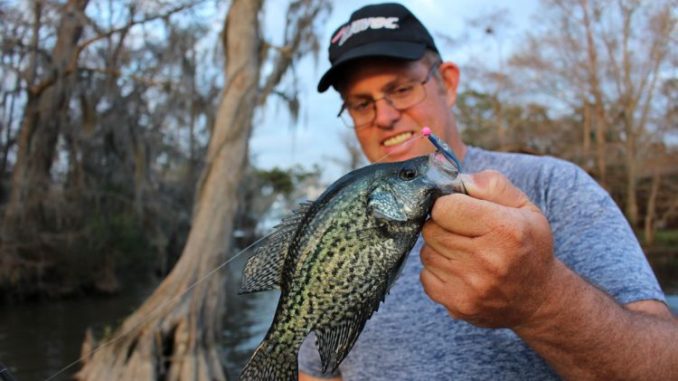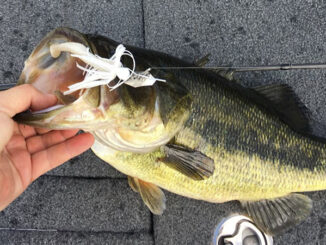
The Tchefuncte River has a reputation as a tough fishery, but the scenic waterway holds a considerable sac-a-lait population. And this is the best month to connect with slabs.
It was America’s least favorite day of the week — a Monday afternoon. The weekend Tchefuncte River boaters had all gone back to work, and Covington’s Jeff Bruhl had all of the main-river cuts to himself.
He had no competition to hunt down the tastiest fish in the nation — sac-a-lait.
And Bruhl said there’s no better time to hit the Tchefuncte than March.
“They’re up spawning and active protecting their nests, so you’re going to catch a lot of fish this time of year,” he said.
As his Phoenix bass boat came off plane, he idled straight into a cut that had produced for him just two days prior.
Little did he know the next time his boat came off plane, he’d be at the dock.
The high sun was shining in full force —not ideal for sac-a-lait — but Bruhl was confident he could catch good numbers of the fish.
In fact, the afternoon sun made the decision of where to fish for sac-a-lait a little bit easier.
“White perch don’t like a lot of sun; they’d rather be in the shade than anything,” Bruhl said. “Docks are really good because they provide shade. You have to fish shady areas.”
When fishing docks, Bruhl prefers a Road Runner to a popping cork. He thinks you can cover more water with them, and he grabs them over a Beetle Spin because he feels like they come over limbs and snags better.
“I’ll use a 1/16- to 1/8-ounce (Road Runner), depending on how deep the water is under the dock and how deep I think the fish are,” Bruhl said.
The angler is pretty particular about his retrieve, explaining that what you do right when the bait hits the water is the key.
“Just reel it back to the boat,” he said. “Sometimes you can shake it, and they’ll hit it that way, but the main thing is to do a countdown.
“You want to try to figure out what depth they’re at.”
When the fish are far back under the dock, skipping the bait is a must.
“I came one day and, early in the morning, the fish were more toward the front of the dock in the deeper water,” he said. “Today, the sun has been up all day, and they seem to be more toward the back.”
Bruhl got multiple bites on each cast and landed a large number of sac-a-lait from under docks.
As the sun moved a little bit lower and clouds started to cover the sun, Bruhl switched to fishing banks with cypress trees.
To do this, he opted for a 1/16-ounce jighead teamed with a blue horizon-colored Matrix Mini beneath a small, Styrofoam cork.
Bruhl said fishing slowly can hurt your efficiency, unless you’re getting bites.
“When I’m hunting them, I’m throwing the cork out, letting it sit for a second or two — and a lot of times I don’t even move it,” he said. “If he’s there, he’s going to bite it this time of year.
“I’ll do that until I get a bite or some nibbles. A lot of times you’ll get some bream bites, and that’s an indication they are trying to steal their eggs. When you get nibbles and bites, slow down because there are probably some crappie in the area.”
Narrowing down the choices
Fishing shady banks opposed to sunny ones is another key to success for sac-a-lait.
“They’re not going to be on a big, wide-open bank unless they’re really spawning hard,” Bruhl said.
He said he occasionally finds fish deep, but usually they are up against cypress trees.
“Sometimes they’ll be 4 or 5 feet off of the bank in a treetop or a laydown,” Bruhl said. “Most of the time, though, they’re going to be about 3 feet deep this time of year when they’re spawning.”
Bruhl rigs both a sliding cork and fixed cork on separate rods, and puts them on the deck of his bass boat. He switches back and forth depending on the cover he is fishing.
“If it’s really shallow and there’s not a lot of cover to hang up on, I’ll use a fixed cork,” he said. “If I’m fishing in heavy cover where I’m dropping the bait straight up and down into a tree top, I’ll use a sliding cork because it doesn’t hang up as much.”
And he varies his depth until he gets a bite.
“The fish will be at a certain strike zone,” Bruhl said. “You might be fishing 1½ feet deep — go down to 3 feet, and you might find that’s the depth where you start getting bites.
“That’ll be where you want to fish the rest of the day.”
When to be there
When fishing a river as condition-dependent as the Tchefuncte, very rarely are all the stars going to align. Bruhl said you can catch fish in less than average conditions, but there are a couple of things that can really make crappie fishing a struggle.
“A big rainstorm can mess it up for a couple of weeks,” he cautioned. “If we get 3 or 4 inches of rain, you’re not going to catch them for a while.”
Wind also can cause problems.
“It’s like any other type of fishing: If you get wind that blows all the water out and a couple of days later it blows it all back in again, it can be hard on the fish,” Bruhl said. “You want stable weather, and the fish will set up in an area and stay there for a couple of days.
“You can catch them pretty good when it’s like that.”
Stay visible
Bruhl said crystal-clear water is not a necessity, but having some clarity to the water can really help anglers out.
“They’re sight-feeders,” he said. “You’re dropping something in their bed, so if they can see it you’ll have a much better chance at catching them.”
If the area is hit with a mild rainstorm, water clarity in the backwaters will stay better than in the surrounding areas, according to Bruhl.
“Usually the (cuts) don’t get too bad, and they’ll clean up before the main river,” he said.
And don’t plan anything else for the day — if you’re looking for an ice chest full of crappie.
That’s because sac-a-lait can easily get you in trouble with your wife because you’ll most likely be staying out a whole lot later than you planned. In fact, you’ll often be forced to break out your running lights, according to Bruhl.
“I can tell you that right at dark or right at daylight is the best times,” he said. “You might fish a pocket or a spot on the river and get one or two fish; then 30 minutes before sundown, you’ll catch 20.
“They just start biting and feeding right as it gets dark.”
That was true on this trip. Bruhl had a blitz of sac-a-lait right at dark and went home with a livewell full of freshwater filet mignon.
The right stuff
There are many types of cover on the Tchefuncte River, including docks, hydrilla, alligator grass, lily pads, laydowns and treetops, but Bruhl said a certain category of cover holds the most fish.
“I find most of the fish are going to be around wood,” he said. “Usually if you get bites around lily pads, it’s bream.”
Unfortunately, fronts are still coming through this month, which means lots of west winds. This can blow too much water out of the Tchefuncte River, resulting in low water levels.
The best bet is to stay home when that happens.
“You want water up around the big cypress trees, because that’s where the fish are going to be this time of year,” Bruhl said. “If the water is pushed out from a front, a lot of times you won’t catch any.”

